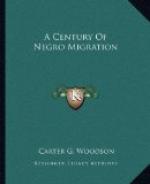This settlement had become attractive to fugitive slaves and freedmen because the Quakers settled there welcomed them on their way to freedom and in some cases encouraged them to remain among them. When the increase of fugitives was rendered impossible during the fifties when the Fugitive Slave Law was being enforced, there was still a steady growth due to the manumission of slaves by sympathetic and benevolent masters in the South.[26] Most of these Negroes settled in Calvin Township, in that county, so that of the 1,376 residing there in 1860, 795 were established in this district, there being only 580 whites dispersed among them. The Negro settlers did not then obtain control of the government but they early purchased land to the extent of several thousand acres and developed into successful small farmers. Being a little more prosperous than the average Negro community in the North, the Cass County settlement not only attracted Negroes fleeing from hardships in the South but also those who had for some years unsuccessfully endeavored to establish themselves in other communities on free soil.[27]
These settlements were duplicated a little farther west in Illinois. Edward Coles, a Virginian, who in 1818 emigrated to Illinois, of which he later served as Governor and as liberator from slavery, settled his slaves in that commonwealth. He brought them to Edwardsville, where they constituted a community known as “Coles’ Negroes."[28] There was another community of Negroes in Illinois in what is now called Brooklyn situated north of East St. Louis. This town was a center of some consequence in the thirties. It became a station of the Underground Railroad on the route to Alton and to Canada. As all of the Negroes who emerged from the South did not go farther into the North, the black population of the town gradually grew despite the fact that slave hunters captured and reenslaved many of the Negroes who settled there.[29]
These settlements together with favorable communities of sympathetic whites promoted the migration of the free Negroes and fugitives from the South by serving as centers offering assistance to those fleeing to the free States and to Canada. The fugitives usually found friends in Philadelphia, Columbia, Pittsburgh, Elmira, Rochester, Buffalo, Gallipolis, Portsmouth, Akron, Cincinnati, and Detroit. They passed on the way to freedom through Columbia, Philadelphia, Elizabethtown and by way of sea to New York and Boston, from which they proceeded to permanent settlements in the North.[30]




